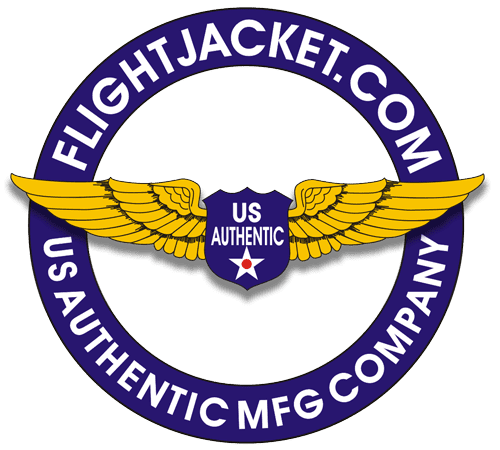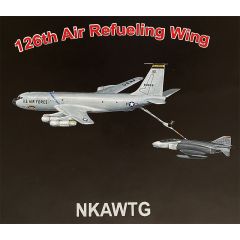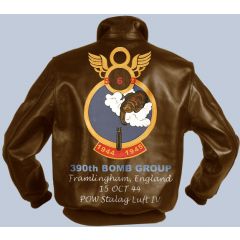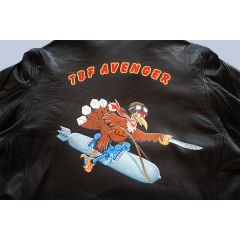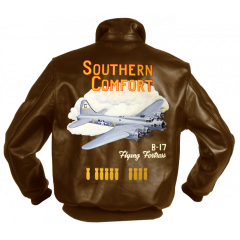Product added to cart
Jackets Art
Our painted flight jackets incorporate beautiful artwork you will appreciate with every wear.
Imprints cost $150 and are available for limited designs. Imprints cannot be customized. To see which designs are available as an imprint visit here
About the US Military Insignia & Nose art.
Insignia originated during World War I. Many were cut out patches of felt and appliquéd on a background. Those most recently produced now are embroidered or painted on leather. Wear war history with pride as you sport our painted flight jackets.
The chief purpose of insignia was to tell of one's organization and grade. The Army and the Navy have their own system. The Marine Corps have a combination of the Army and the Navy and the Coast Guard use an abbreviation of the Navy system.
Soldiers paid attention to insignias and specifications for each device, and the directions for wearing them were followed exactly. Close attention to dress code was important because it served as an aid to recognition, and as an element to create and support pride, as well as a means of establishing and maintaining discipline. Rather than using numbers for identification, symbols were used because they expressed warmth and fraternity. Wearing the insignia provided a source of pride in oneself and in one’s organization. This pride promoted self-discipline, the essence of respect for self, for service, and for the country. George Washington devised badges early during the Revolutionary War so that rank could be readily identified. Since the Revolution, the number of insignia has multiplied, and their purposes have expanded.
The insignia was and still is worn on the left sleeve below the shoulder to denote divisions, corps, and armies. They resembled in purpose the enameled badges of the Civil War and Spanish-American War.
In 1918 the first shoulder sleeve insignia was credited for members of the 81st Division. General Headquarters recognized its value of building morale and of helping troops reassemble under their own officers after an offensive. Subsequently, all organizations of the American Expeditionary Force were directed to adopt similar insignia.
New designs did not conflict with existing ones, nor did they resemble a symbol employed by the enemy. Instant recognition of insignia was essential. Most of the insignia used by the United States Army were based on historic facts or on some attribute of the organization concerned. Local stories or mythology were often the basis of design. Army arm and service insignia ordinarily included adaptations of early weapons. Many insignia showed strong links with naval tradition antedating the creation of our Navy. To simplify manufacture and to aid memory, only one combination of colors for each insignia was authorized. All designs were simple, preferable in silhouette. Not only were military insignia authorized, they were prescribed for wear as directed.
The army air forces insignia was approved on March 21, 1942. The original army insignia for its planes was the basis for the Army Air Forces shoulder sleeve insignia. The insignia for the planes was a blue circle with a white star on which was superimposed a red disk. For the shoulder sleeve gold wings were added to the design. In the plane insignia, the red disk was dropped in 1942 because it was confused with the Japanese plane insignia, but the original design was maintained in the sleeve insignia. The ultra marine disk represented the sky and air. The golden wings surmounting the star are an indication of victorious operation.
The artwork for aircraft insignia, known as nose art, became popular during World War II. It was funny, grim and youthful. It stemmed by the desire to personalize an object and make it unique. A thousand B-17s, identical in every way, rolled off the assembly line and flew into an uncertain fate, and each one was different. The difference was the nose artwork painted on the cockpit which expressed the personalities and imagination of the fighters. The images painted on their planes personified their missions into stories about their fights and their victories. Few crews would talk about 247613 or 34356, but many tales would be told about “Sack Time” or “The Dragon Lady”
The ideas for nose art came from girlfriends, wives, posters, calendars, the comics, and events to the history of the aircraft. The majority of the artwork was inspired by the artwork in the magazines and calendars of the time. This included Disney characters and the Vargas girls. These recognizable designs can now be found on the back of our nose art bomber jackets.
The artwork was painted on the plane by anyone. Those units fortunate enough to have a talented artist produced excellent nose art. When painting the plane, the artist first did his sketch. After his squadron colleagues have given assent, the artist would begin his painting on the aircraft. These designs expressed feelings of determination, destructive fighting power, readiness, as well as knowledge of flight, keen vision, fierce pursuit, able and strength.
Squadron insignia in size was two or three feet in diameter and were painted on both sides of the planes, generally near the cockpit. The images were not permitted in zones of operation. The Squadron designs were so much in favor that without official approval they were embroidered and worn as breast patches on left pockets of flight jackets. Names and designs for individual planes were painted on both sides of the cockpit.
Aircraft insignia expressed the spirit, goal and mission of the flying fighter and his organization. It helped boost moral and leadership for the fighters who began everyday with an uncertain fate.
To see Nose art work in progress, visit the VS-21 decommissioning page here.Celebrate history today. Our custom nose art bomber jackets are bound to strike up memorable conversation.

